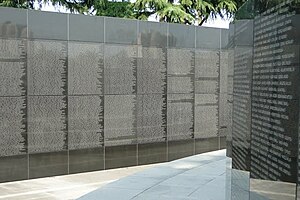Nam District, Busan
The Busan International Finance Center is located here.
Demographics
Nam District is home to some 300,000 people, for a population density exceeding 11,000 per square kilometer. Less than 1,000 of its inhabitants are non-Korean.
Busan Subway
The Busan Subway (line 2) passes through Nam District, where an interchange connects it to the highway leading to the Gwangan Bridge. Six subway stations along Busan Subway (line 2) are located in Nam District, going from Kyungsung University · Pukyong National University Station to Busan International Finance Center Station.
Geography
Nam District contains a total of 7 islands, all uninhabited, with a total area of only 0.3 km. Among these are the Oryukdo islets which mark the entrance to Busan Harbor. The highest point of Nam District lies inland: the peak of Hwangnyeongsan, at 427 meters above sea level. Hwangnyeong-san also marks the point where Nam District's borders meet those of Yeonje District and Busanjin District.
Administrative divisions

Nam District is divided into 6 legal dong, which altogether comprise 17 administrative dong, as follows:
- Daeyeon-dong (5 administrative dong)
- Yongho-dong (4 administrative dong)
- Yongdang-dong
- Gamman-dong (2 administrative dong)
- Uam-dong
- Munhyeon-dong (4 administrative dong)
Education

A number of institutions of higher education, including 6 universities, are located in Nam District. It includes Pusan University of Foreign Studies, Kyungsung University, Tongmyong University, and Pukyong National University.
Universities with graduate schools
- Pusan University of Foreign Studies (PUFS)
- Pukyong National University (PKNU)
- Kyungsung University
- Tongmyong University
Other institutes of higher education
Secondary schools
Other features
The district is home to the United Nations Memorial Cemetery, which contains graves of United Nations Command soldiers of the Korean War.
The district also hosts Busan Naval Base.
Sister city
See also
Notes
This article needs additional citations for verification. (December 2008) |
- ^ Nam District office population register, June 30, 2006. Nam District website (in Korean)
- ^ Nam District statistical yearbook 2004, 토지와 기후 (Toji-wa Gihu) (Land and climate), table 3. Electronic version (HWP format)
- ^ Nam District statistical yearbook 2004, 인구 (In-gu) (Population). Electronic version (HWP format)
- ^ Nam District statistical yearbook 2004, 토지와 기후 (Toji-wa Gihu) (Land and climate), table 1. Electronic version (HWP format)
References
- ^ "Population statistics". Korea Ministry of the Interior and Safety. 2024.
External links
- Nam District website (in English)
 Central Busan travel guide from Wikivoyage
Central Busan travel guide from Wikivoyage